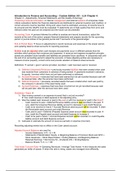Samenvatting
IFA Summary - Chapter 4 Accounting LLH
- Instelling
- Universiteit Utrecht (UU)
UU Introduction to Finance and Accounting - Summary of Chapter 4 of the Accounting Textbook 'Introduction to Finance and Accounting Custom Edition UU' by Libby, Libby, Hodge
[Meer zien]




